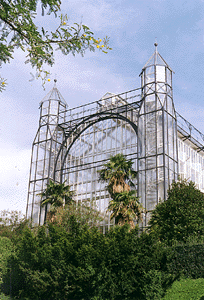Greenhouses - House P
|
Woody plants from the Mediterranean evergreen forests and macchia shown here include Quercus ilex, Arbutus unedo, Myrtus communis, Laurus nobilis, Phillyrea latifolia, Erica arborea, Cupressus sempervirens, and Juniperus phoenicea. The characteristic pine species of the zone can only be present as young specimens. Evergreen subshrubs like Ruscus aculeatus and the typical lianas of the zone, Smilax aspera and Asparagus acutifolius are grown here as well. Plants of great economic importance native to the Mediterranean area are the olive tree, Olea europaea, cork oak, Quercus suber, and the carob, Ceratonia siliqua. The two palms native to the area, Chamaerops humilis from the western Mediterranean, and Phoenix theophrasti from Kreta are shown here. Of the palms originally introduced from eastern Asia but widely planted in Mediterranean parks and gardens, Trachycarpus fortunei can be seen outside between the glasshouses and the "Italian Garden" during summer. Plants of the vegetation types known as "Garigue" in France, "Phrygana" in Greece, and "Tomillares" in Spain are arranged here in two separate displays using basically different substrates, one with limestone rock and one with granitic substrate. Numerous aromatic Labiates like Lavandula and Rosmarinus, but also many species of the Legume and Composite families as well as Cistus species and even the wild relatives of the cabbage plant (Brassica) form part of a natural display with numerous in species. Photo: In the Mediterranean house. Another part of this house is dedicated to plants from the Maccaronesian Region (Canary Islands, Madeira, Azores). Among the trees and shrubs of the laurophyllous zone, Laurus azorica, Persea indica, and Apollonias barbujana may be mentioned. The lianas are represented by Semele androgyna (Liliaceae). The true centerpiece of a display of plants of more arid zones is a large specimen of Dracaena draco. When it was planted here in 1992, it was about 60 years old and had flowered only once. It is just beginning to form a crown and thus approaching the habit of the legendary dragon trees, the age of which has been tremendously over-estimated. Other gems of the Maccaronesian flora are the large rosette forming Echium species with tall pyramidal terminal inflorescences, the bell-flowered Canarina canariensis from the Canary Islands and Campanula vidalii (=Azorina vidalii) from the Azores, both of the Campanulaceae. The Canary Island date palm, Phoenix canariensis, would grow too large in here. Large potted specimens beginning to form a stout trunk can be seen in summer outside along the main path in the "Italian Garden". The numerous introduced plants frequently found in gardens and parks or even naturalized in the Mediterranean area are not considered here. Some of them, particularly citrus species and cultivars, which are an important part of the landscape and economy of the Mediterranean area today, are temporarily exhibited outside the glasshouse as potted plants. In the tree fern grove, old specimens of Dicksonia antarctica and Sphaeropteris cooperi reach 10-15 m almost to the roof. The cool and moist climate of this house is maintained by simple and traditional technical means, particularly the tall back wall covered with porous lava rock has an important function. In the course of decades, numerous ferns have established themselves on it. In the herbaceous cover, Selaginella martensii and ferns like Pellaea rotundifolia und Woodwardia radicans are conspicuous. The gymnospermous tree Araucaria heterophylla from the Norfolk-Island has grown tall under the favourable conditions given here. B. Leuenberger |






 House P, the second largest glasshouse in the garden and standing separate from the main glasshouse complex, is an architectural monument designed by the architect Alfred Koerner and built between 1903 and 1908. It was carefully renovated between 1989 and 1993. With its "Jugendstil" ornaments it represents a more traditional style than the Tropical House, and with two spires it is reminiscent of a cathedral - a cathedral for plants. Since 1994, the front part (Pa) houses a display of Mediterranean and Canary Island plants. The back part (Pb) with its impressive old grove of tall tree ferns was established here already at the beginning of the twentieth century.
House P, the second largest glasshouse in the garden and standing separate from the main glasshouse complex, is an architectural monument designed by the architect Alfred Koerner and built between 1903 and 1908. It was carefully renovated between 1989 and 1993. With its "Jugendstil" ornaments it represents a more traditional style than the Tropical House, and with two spires it is reminiscent of a cathedral - a cathedral for plants. Since 1994, the front part (Pa) houses a display of Mediterranean and Canary Island plants. The back part (Pb) with its impressive old grove of tall tree ferns was established here already at the beginning of the twentieth century.